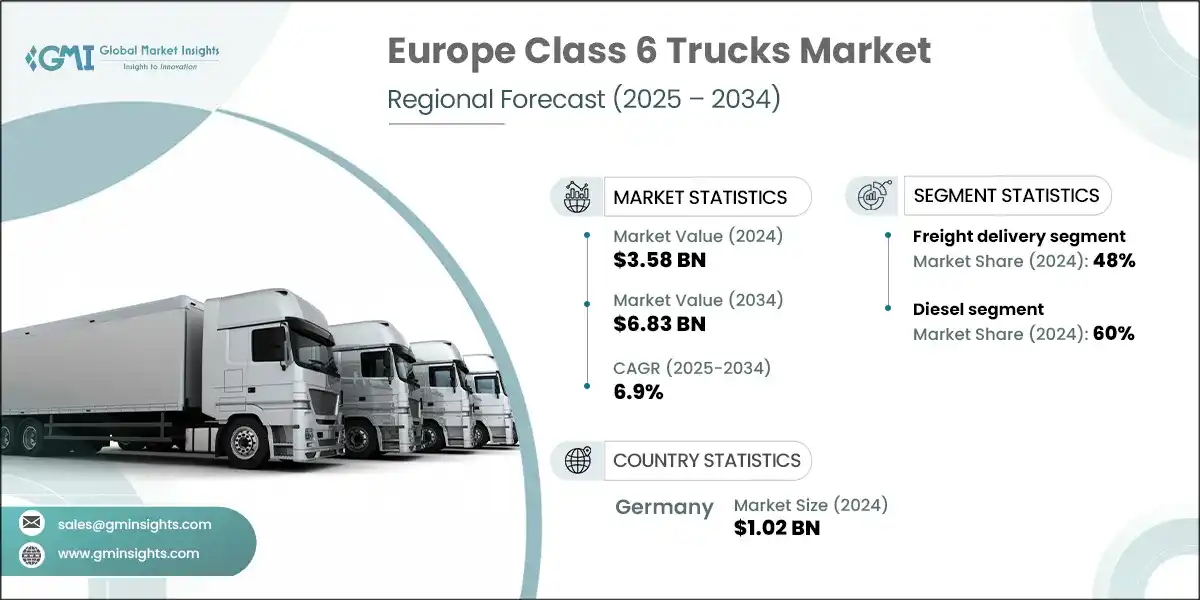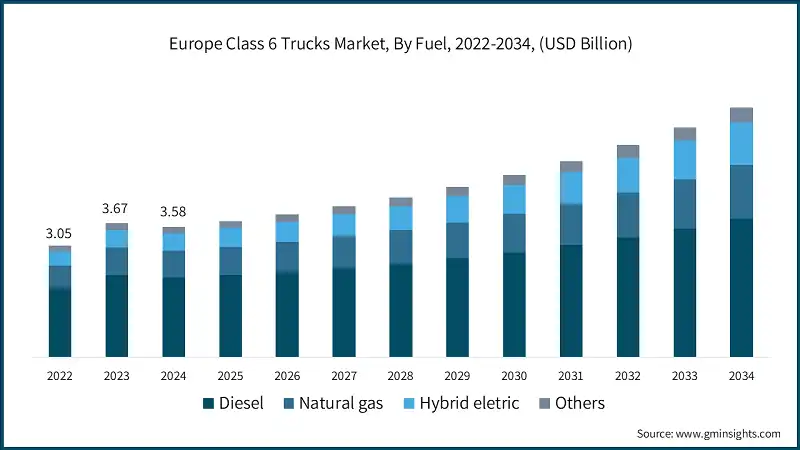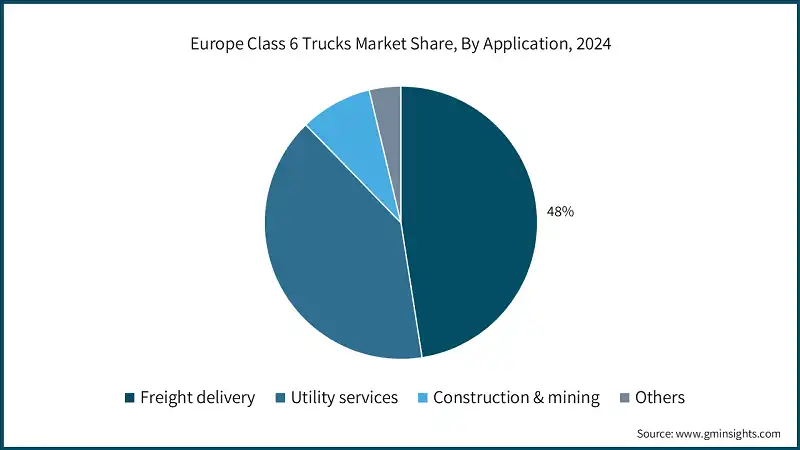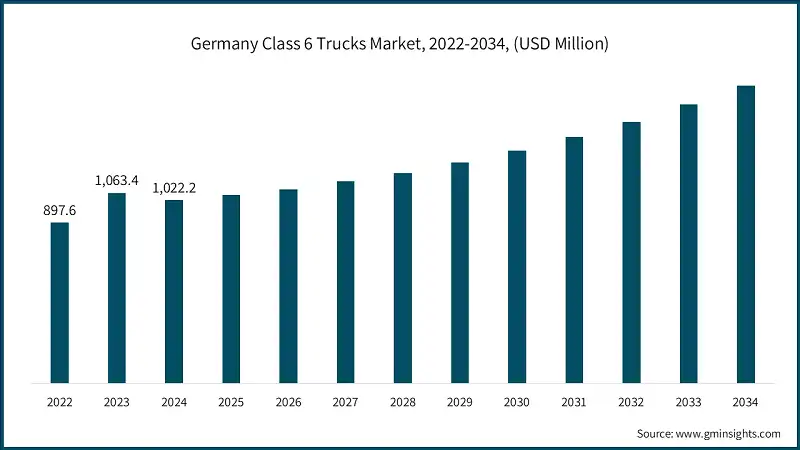Summary
Table of Content

Europe Class 6 Trucks Market
Get a free sample of this report
Thank you!
Your inquiry has been received. Our team will reach out to you with the required details via email. To ensure that you don't miss their response, kindly remember to check your spam folder as well!
Form submitted successfully!
Error submitting form. Please try again.

Request Sectional Data
Thank you!
Your inquiry has been received. Our team will reach out to you with the required details via email. To ensure that you don't miss their response, kindly remember to check your spam folder as well!
Form submitted successfully!
Error submitting form. Please try again.
Europe Class 6 Trucks Market Size
The Europe class 6 trucks market size was estimated at USD 3.58 billion in 2024. The market is expected to grow from USD 3.73 billion in 2025 to USD 6.83 billion in 2034, at a CAGR of 6.9%.

To get key market trends
- The light-duty vehicles offered costly options with minimal payload capacities; fleet operators have been more concerned with the expansion of e-commerce since 2015. The last-mile delivery boom during the COVID-19 pandemic significantly increased the use of Class 6 trucks, alleviating transportation bottlenecks. Demand in European city centers will continue to grow due to suburban expansion and the creation of no-emission delivery zones.
- In March 2025, according to a report by DS Smith, last-mile delivery expenses in Europe have increased by as much as 90%, primarily because of increased usage of delivery vehicles in urban centers stemming from e-commerce growth.
- Since the introduction of Euro VI standards after 2014, compliance for cleaner Class 6 vehicles is now being better enforced. Operators had been slow to update their fleets to more compliant vehicles due to confusion and very limited and non-penal consequences. The Euro VII standards and continued tightening of carbon footprints by 2030 will speed the uptake of lower and zero emissions truck.
- The post economic recovery efforts of 2009 and pandemic stimulus packages after 2020 have both incentivized the updating of fleet vehicles. Previously, operators hesitated to adopt modern fleet vehicles because of high capital costs and lack of return on investment. Going forward, automated compliance systems and environmental financing will drive the phasing out of older Class 6 fleets.
- The increasing use of Class 6 truck since 2010 noticed a rise as a result of an increase in need from the construction as well as municipal industry, however earlier demand was tempered by the recession and limited spend on infrastructure. The peak demand experienced was due to the EU's infrastructure stimulus from 2018 to 2020. Continued growth in the market is expected due to the implementation of public procurement processes and initiatives related to modernizing roads.
- In December 2024, the European Union’s transport chief Ondole Apostolos Tzatzikis announced an investment plan of €17 billion to upgrade 500 transport infrastructure corridors such as roads and bridges. The plan is intended to enable swift movement of both military and civilian cargo throughout Europe and rectify some of the existing infrastructural gaps.
- Europe's emission regulations coupled with developed road infrastructure and a booming mid-weight Class 6 truck urban e-commerce demand support the region's focus on sustainability with smart logistics systems. Thus, Europe leads the market in mid and regionally deployed clean vehicles.
Europe Class 6 Trucks Market Report Attributes
| Key Takeaway | Details |
|---|---|
| Market Size & Growth | |
| Base Year | 2024 |
| Market Size in 2024 | USD 3.58 Billion |
| Forecast Period 2025 – 2034 CAGR | 6.9% |
| Market Size in 2034 | USD 6.83 Billion |
| Key Market Trends | |
| Drivers | Impact |
| Urban logistics expansion | Rise in e-commerce and last-mile delivery needs boosts demand for agile, medium-duty trucks in city centers. |
| Infrastructure modernization initiatives | EU’s €17 billion transport upgrade fuels demand for Class 6 trucks in construction and municipal operations. |
| Stricter emission regulations (Euro VI & upcoming Euro VII) | Fleet upgrades accelerate as operators shift to cleaner, regulation-compliant medium-duty vehicles. |
| Public procurement reforms | Green and digital procurement policies favor modern, fuel-efficient Class 6 trucks for government contracts. |
| Pitfalls & Challenges | Impact |
| High upfront cost of electric trucks | Slows adoption among small and mid-sized fleet operators despite regulatory push for zero emissions. |
| Limited charging and refuelling infrastructure | Restricts the operational range and scalability of clean Class 6 trucks. |
| Opportunities: | Impact |
| Expansion of urban micro-warehousing and last-mile delivery networks | Drives demand for agile, mid-weight Class 7 trucks in city logistics. |
| Advancements in battery and hydrogen fuel technologies | Enhances range, efficiency, and affordability of low-emission trucks. |
| Market Leaders (2024) | |
| Market Leaders |
26% market share |
| Top Players |
Collective market share in 2024 is 49% |
| Competitive Edge |
|
| Regional Insights | |
| Largest Market | Western Europe |
| Fastest Growing Market | Eastern Europe |
| Emerging Countries | Netherlands, Romania, Estonia, Greece |
| Future outlook |
|
What are the growth opportunities in this market?
Europe Class 6 Trucks Market Trends
- The movement to electric Class 6 trucks was influenced by early emission regulations, city policies and new lightweight battery technologies. In mid-2020's, wider adoption is encouraged through city policies, which encourage emission reductions, supportive government policies for electric vehicles and lower maintenance costs. In 2025 and 2026, Class 6 Electric trucks are predicted to dominate European city logistics and short haul delivery.
- In June 2025, the Danish government increased its funding for electric trucks from DKK 75 million to DKK 425 million for the years 2025 to 2026. The updated policy now permits leased trucks to participate, improving operator access and incentivizing further investment in electric vehicle fleets leading to the adoption of emission-free trucks for urban logistics and short-haul delivery.
- The integration of digital fleet management after 2016 began to pick up, as logistics companies began to use telematics to improve operational efficiency. During the telematics-driven boom, especially throughout the pandemic logistics crunch, digital fleet management usage reached its apex. In future, comprehensive digitalization is going to change the way urban Class 6 fleets are going to be managed in a cost-efficient, automated, and eco-friendly manner.
- The pilot programs implementing bio-CNG and hydrogen fuels commenced around 2019 alongside diesel and electric options. As infrastructure gradually improves and policies enforcing environmentally friendly fuels become stricter, these alternatives are better suited for integrated suburban and metropolitan transit systems. They are anticipated to aid in diversifying transport fleets in areas where electric options are not yet practical.
- In June 2025, Germany: Vigo Bioenergy, Bosch and IVECO have powered an IVECO S-Way truck using pure bio-LNG (its bio-CNG equivalent) with digital fuel twin technology to track fuel origin. This effort was done as part of 'Tour Europe' which promotes eco-friendly logistics alternatives for heavy-duty vehicles.
- OEM collaborations and innovations from 2020 appeared as contractors partnered with tech and logistics startups to develop bespoke urban Class 6 chassis. By 2025, enhanced flexibility of these models will have already been gained due to embedded electronics as well as modular design. These mutually developed trucks will ultimately exemplify the urban workhorse multifunction, advanced networked communication, and emissions compliant regulation.
Europe Class 6 Trucks Market Analysis

Learn more about the key segments shaping this market
Based on fuel, the Europe class 6 trucks market is divided into diesel, natural gas, hybrid electric and zero-emission vehicles. The diesel segment dominated the market accounting for around 60% in 2024 and is expected to grow at a CAGR of 6% through 2034.
- The diesel segment continues to thrive in the market due to its superior fuel consumption, higher torque, fuel economy, and general access to service stations located at regional and municipal diesel stations. The Class 6 trucks have held and appear to hold commanding market positions sustained mostly in regions where electric vehicle and hydrogen fuel infrastructure still have some significant development to do.
- The Europe class 6 trucks market from hybrid electric grow at 9% CAGR till 2034, due to their alternative solutions to address urban air pollution and greenhouse gas emission challenges, particularly where complete electrification is not feasible yet. HEVs enhance fuel economy, and emission and noise pollution control during low-speed urban driving.
- In December 2024, Stellantis advanced the launch date for the hybrid RAM 1500 charger pickup due to slackening demand for EVs, insufficient charging facilities, and increasing interest in hybrid cars. The automaker claimed ‘overwhelming’ customer enthusiasm for the hybrid model and accelerated the customer order timeline to forgo the wait for the fully electric model, now pushed to 2026.
- The natural gas is rising as it is cheaper in price and less polluting than diesel. Italy and Germany already have advanced natural gas refueling infrastructure. Increased natural gas adoption is also being aided by less governmental support and more aggressive pollution regulations.

Learn more about the key segments shaping this market
Based on application, the Europe class 6 trucks market is segmented into freight delivery, utility services, construction & mining and others. The freight delivery segment dominates the market with 48% share in 2024, and the segment is expected to grow at a CAGR of over 7% from 2025 to 2034.
- Freight delivery has the highest share in terms of value in the Europe Class 6 trucks market, due to an increase in demand for regional distribution and last-mile delivery motor transport amid the growth of e-commerce and retail logistics. The advantages of Class 6 trucks from a fuel economy, agility and payload perspective makes them a dominant option for intra-city and short distance inter-city freight transport.
- In February 2025, DHL Group’s subsidiary implemented 21 new electric vans in Lower Saxony, Saxony, Berlin, Bavaria and Baden-Württemberg for the large and bulky e-commerce furniture and appliance deliveries. This move is in line with the group’s sustainability goals and greatly reduces CO2 and diesel emissions.
- The Europe class 6 trucks market from construction and mining grow at 7% CAGR through 2034, due to capability to transport a significant load over rough terrain. The sustained expansion of construction and mining activities in Europe reinforces the demand for such reliable trucks.
- The Europe Class 6 trucks market is driven by the utility services because these trucks are used by utilities for waste collection, street cleaning, and maintenance of public works. Their mid-range size classification strikes a good compromise between payload and weight as well as agility in and around the crowded metropolitan and suburban regions.
Based on horsepower, the Europe class 6 trucks market is segmented into 200–300 HP and 300-400 HP. The 300-400 HP segment is expected to dominate as the ideal balance between power and fuel efficiency, making it suitable for long-haul freight and regional transport.
- The 300-400 HP segment drives the Europe Class 6 trucks market delivering a balanced combination of fuel economy and operational effectiveness for metropolitan and regional short-haul activities. This power band aids emission and fuel cost efficiency for daily logistics and utility activities alongside light excavation and construction work.
- In May 2025, Scania revealed the new Super 11-liter diesel engine with options for 350 hp, 390 hp, and 430 hp. The engine designed for fuel and weight sensitive applications offers 7% fuel saving compared to its 9-liter predecessor and is also 85 kg lighter than the 13-liter Super unit.
- The Europe class 6 trucks market from 200-300 HP segment grows at 7% CAGR from 2025 to 2034 as trucks with horsepower between 200 and 300 are better for fuel economy and intra-city and peri-urban distribution activities due to better torque management and reduced engine strain.
Based on body, the Europe class 6 trucks market is segmented into box, dump, beverage and others. The box segment is expected to dominate as businesses emphasize fuel efficiency, total cost of ownership, and emission compliance, demand has risen for low-maintenance, durable and performance-optimized box configurations.
- Box trucks hold the highest Europe class 6 trucks market share due to their enclosed and secure cargo spaces that shield products from damage due to weather and thievery. Thus, they are very appropriate for retail, e-commerce and FMCG distribution. Their operational efficiency is improved by the flat cargo floor and the customizability of the truck bodies.
- In July 2025, Hived, the UK-based e-commerce logistics company, has raised $42 million in funding, which will be allocated towards expanding their fleet of fully electric box trucks, specifically the Mercedes-Benz eActros 600, in London, Bristol, Bath and Brighton.
- The Europe class 6 trucks market from dump grows at 7.8% CAGR up to 2034, as it is equipped with a hydraulic tipper which makes unloading more efficient and faster and improves job site productivity. It is designed to operate in rough terrain in urban and suburban areas, including in fast moving and frequent short drives in roadworks and other utility services, which is brought about by its high payload capacity and rough terrain capability.
- The beverage sector is a critical component of the Class 6 truck market predominately search exceeding medium duty trucks for regional distribution, from bottled water to soft drinks, juices, and alcoholic beverages. Class 6 trucks can provide the required payload delivery capacity, convenience and maneuverability and available temperature-controlled options for food products required to make regional deliveries on time.

Looking for region specific data?
Germany dominated the Western Europe class 6 trucks market with around 28% share and generated USD 1.02 billion in revenue in 2024.
- Germany leads in the Europe class 6 trucks market due to manufactured freight industry, spatially concentrated logistics infrastructure and interest in local and regional freight activities. In addition, Germany’s environmental policies on her use of medium-duty trucks for urban and public sector construction work, public transport, and construction civics works in the subsidized fleet ‘green’ fleet modernizations promote urban freight and public transport.
- In July 2024, the German government announced an initiative to construct a system of 350 rapid charging stations along the autobahns spanning nearly 95% of the national road network as part of the country’s aim to fully electrify one-third of its heavy-duty freight transport by 2030.
- The investment in France’s Class 6 truck market is being highlighted by sustainable logistics policies, enforcement of EU emissions regulations, and fleet digitization. There is constant demand in the municipal, utility, and regional freight sectors.
- The truck Class 6 market in the Netherlands and Ireland is propelled by the focus on green mobility strategies and subsidization alongside emission policies in the EU and local governing bodies. Both countries have dynamic urban logistics as well as port sectors which require efficient short-haul and last mile transport.
The class 6 trucks market in Eastern Europe is expected to experience significant and promising growth from 2025 to 2034.
- Poland is one of the main emerging markets for Class 6 trucks in Europe. Additionally, it is a recipient of European Union financial support for infrastructure development, hosting several logistics and warehouse centers. Moreover, Poland is a forerunner in adopting clean transport policies, as well as in modernizing trucking fleets.
- In March 2025, Poland has announced two funding programs worth €440 million each to bolster the electrification of heavy transport. The funding covers: the construction of charging stations and the purchase or leasing of N2/N3 zero-emission trucks along pivotal TEN-T corridors and at logistics hubs.
- The Czech Republic is expanding, due to its steep policies in automotive production, logistics and infrastructure spending from the EU. In addition, its e-commerce industry and new record high in car production (774,000 units in H1 2024) is creating an even greater need for freight and utility services. The Czech Republic's road freight transport industry is projected to grow at a rate of roughly 3.12% from 2025 to 2030.
- Romania and Serbia are experiencing higher demand for Class 6 trucks with the modernization of infrastructure, increased cross-border trade and the growth of logistics hubs in the region. With the alignment to EU regulations, the two countries are also making better fleet emissions and fuel standards with the adoption of newer, more efficient trucks.
The class 6 trucks market in Northern Europe is expected to experience significant and promising growth from 2025 to 2034.
- Sweden’s policies toward green transport and forward-thinking logistical infrastructure make it Europe’s market for Class 6 trucks Sweden’s approach to electric and hybrid vehicles as well as older medium-duty vehicles facilitates expanding demand from urban electric delivery, utility and short-haul freight.
- In March 2025, Sweden introduces a new road toll system for heavy vehicles over 12 tons which will be based on the Euro emissions class and CO2 efficiency. Older trucks will be encouraged to lower CO2 emissions due to significantly reduced toll rates, which will aid the adoption of Euro 6 and newer medium-duty trucks, including cleaner diesel and Class 6 electric models.
- Norway’s goal to fully decarbonize heavy-duty transport by mandating 50% adoption of zero-emission trucks by 2030 and complete transition to emission-free heavy vehicles by 2040 is flocking fleet renewal. Enova’s recent funding of €11.5 million to subsidize the deployment of over 100 electric commercial vehicles and the construction of 108 fast-charging hubs along important corridors is accelerating fleet renewal.
- The two countries transform into remarkable markets for Class 6 trucks because of the updated infrastructure and clean logistic focus in Estonia and Lithuania. Lithuania's law on the alternative fuels and subsidies for electric truck’s fleet changes are likely to lead to a renewed forward-looking shift to Euro 6 and 0-Emission trucks. Meanwhile in Estonia there is a growing appetite for electric trucks even though there are still not enough charging stations for the trucks.
The class 6 trucks market in Southern Europe is expected to experience significant and promising growth from 2025 to 2034.
- The Class 6 truck market in Italy is expected to increase, this growth is driven by the increase in the country's transport and manufacturing industries. Evolving technological frameworks in e-commerce coupled with the enhancement of infrastructural avenues is causing a shift towards the adoption of environmentally friendly and emission compliant fuel Class 6 vehicles.
- Spain is fastest growing market for Class 6 trucks as a result of the rapid increasing logistics sector, strong infrastructure development, and the surge in e-commerce and freight transport.
- The development of logistics frameworks, tourism, retail and construction sectors are simultaneously elevating the demand for Class 6 trucks in Turkey and Greece. As inter-country trade and e-commerce increase in volume, the emphasis on logistics frameworks shifts towards emission-control regulations and the usage of environmentally friendly transport options.
- Greece is a burgeoning market for Class 6 trucks, fueled by booming demand for urban logistics, construction, and tourism in transportation. Greece is also modernizing its transport networks and, through EU-supported sustainability initiatives, is encouraging a shift towards more sustainable and efficient vehicles. While diesel is still popular, electric trucks are beginning to emerge into the marketplace, primarily in Greek urban centers such as Athens and Thessaloniki, where the regulations around emissions and last-mile delivery needs are heightened.
Europe Class 6 Trucks Market Share
- The top 7 companies in the Europe class 6 trucks market are Daimler Truck, Ford Otosan / Ford Trucks, IVECO, PACCAR, Tata Motor, TRATON Group and Volvo Group contributing around 52% of the market in 2024.
- Daimler Truck is a global leader in the manufacturing of commercial vehicles and operates the Mercedes Benz, Freightliner, and FUSO brands. The company is heavily invested in zero-emission battery electric and hydrogen fueled fuel cell trucks. In addition, the company has further advanced in autonomous driving technology and digital fleet management.
- Volvo is a key player in the heavy-duty truck segment of the Volvo Group. The company has electric and hydrogen fueled with fuel cell trucks in development. Volvo further prioritizes safety, sustainability, and innovation along with offering driver assistance technologies.
- PACCAR is the parent company of well-known truck brands like Kenworth, Peterbilt, and DAF. These brands are recognized for high-performance, durable trucks in North America and Europe. PACCAR is diversifying through investments in the electric and autonomous technologies ecosystem, and is known for excellent aftermarket support.
- Iveco Group, an Italian company, manufactures light, medium and heavy commercial vehicles, as part of the group, Iveco also produces light vehicles. Furthermore, the company is also known for researching with pioneering work on electric vehicles and natural gas alternative fuels.
- Part of Ford Otosan, Ford Trucks is dedicated to the heavy commercial vehicle segment in Europe, the Middle East and other developing countries. Ford is known for the F-MAX long haul truck and is working on electric and fleet versions that are managed digitally to broaden its product portfolio.
- Tata Group, through Tata Motors, is an important participant in the Class 6 truck market, particularly in Asia, Africa and the Middle East. With products which are trusted and low-cost, Tata supports a variety of applications including construction, logistics and municipal delivery.
- TRATON Group which includes Scania, MAN, and Volkswagen Truck & Bus have a strong presence in the European Class 6 truck market. They also focus on innovation in safety, electrification and connected services to align with Europe’s environmental sustainability goals.
Europe Class 6 trucks Market Companies
Major players operating in the Europe class 6 trucks industry are:
- Ashok Leyland
- Daimler Truck
- Ford Otosan / Ford Trucks
- Hyundai Motors
- Isuzu
- IVECO
- MAN Truck & Bus
- PACCAR
- Scania
- Volvo Group
- Daimler, Ford Trucks (Otosan) and IVECO are progressing rapidly toward the decarbonization goals Ford Trucks and IVECO are collaborating for development of new heavy-duty cabins complying with EURO safety and emission standards, while Daimler has released eActros 600 targeted for long-haul logistics.
- PACCAR and MAN Truck & Bus are also focusing towards the adoption of clean technologies. PACCAR is extending the electric truck offering by DAF to other European parts, while MAN rolled out long-range modular electric trucks for long-haul transportation. Quantron has also launched an ultra-long-range hydrogen powered truck specifically targeted towards emission-free freight logistics, the QHM FCEV AERO.
- Both firms Ashok Leyland and Hyundai Motors are progressing towards green mobility. Hyundai collaborates with IIT Madras for hydrogen technology and is introducing new EVs including the Creta EV. Moreover, Ashok Leyland is expanding its portfolio with Switch Mobility and is investing INR 1,000 crore in alternate propulsion technologies.
- Just like IVECO, Ford Trucks and Isuzu are focusing fleet safety and digital transformation. Ford Trucks has implemented smart freight telemetry, while IVECO is working on connecting Driver Pal services. Isuzu has incorporated ADAS into its N Series trucks.
Europe Class 6 Trucks Industry News
- In July 2025, Traton (Volkswagen’s truck group) reported a robust 11% growth in European orders, which includes medium duty trucks. Replacement needs are driving the Class 6 fleet turnover.
- In July 2025, Tata Motors completed the purchase of Iveco's truck and bus business for €3.8 billion. This purchase was part of a major business restructure of Tata Motors. As a major OEM of medium-duty trucks in Europe, Iveco's purchase is expected to transform the landscape of commercial vehicles.
- In June 2025, DHL will lease 30 eActros 600 electric trucks from Mercedes Benz for parcel transport throughout Europe, renting them on a per kilometer driven basis. The electric trucks will be delivered by mid-2026 which will help accelerate the shift to electric medium duty fleets.
- In June 2025, the Danish government increased funding for electric trucks from DKK 75 million to DKK 425 million for the years 2025-2026 and changed the policy to allow leased trucks to join in, improving access for operators while creating an incentive for fleets to go electric. This improves the adoption of emission-free trucks for urban logistics and short-haul delivery.
- In March 2025, Daimler Truck is implementing a €1.1 billion cost reduction initiative spanning Europe after a profit dip of 15% in 2024. This moderate-duty segment alongside the enduring operational efficiency improvements is aimed in profit-achieving stubborn enduring pressures.
The Europe class 6 trucks market research report includes in-depth coverage of the industry with estimates & forecasts in terms of revenue (USD Million) and shipments (units) from 2021 to 2034, for the following segments:
Market, By Fuel
- Diesel
- Natural gas
- Hybrid electric
- Others
Market, By Body
- Box
- Dump
- Beverage
- Others
Market, By Horsepower
- 200-300 HP
- 300-400 HP
Market, By Axle
- 4X2
- 6X4
- 6X6
Market, By Application
- Freight delivery
- Utility services
- Construction & mining
- Others
The above information is provided for the following regions and countries:
- Western Europe
- Austria
- Belgium
- France
- Germany
- Ireland
- Luxembourg
- Monaco
- Netherlands
- Switzerland
- United Kingdom
- Eastern Europe
- Bulgaria
- Croatia
- Czech Republic
- Hungary
- Poland
- Romania
- Serbia
- Slovakia
- Slovenia
- Ukraine
- Northern Europe
- Denmark
- Estonia
- Finland
- Iceland
- Latvia
- Lithuania
- Norway
- Sweden
- Southern Europe
- Albania
- Greece
- Italy
- Portugal
- Spain
- Turkey
Frequently Asked Question(FAQ) :
Who are the key players in the Europe class 6 trucks industry?
Major players include Ashok Leyland, Daimler Truck, Ford Otosan/Ford Trucks, Hyundai Motors, Isuzu, IVECO, MAN Truck & Bus, PACCAR, Scania, and Volvo Group.
What are the upcoming trends in the Europe class 6 trucks market?
Key trends: adoption of electric Class 6 trucks, rising emission-free vehicle funding, digital fleet management, bio-CNG/hydrogen pilots, and OEM collaboration on modular, emissions-compliant designs.
What was the market share of the freight delivery segment in 2024?
The freight delivery segment held a 48% market share in 2024 and is set to expand at a CAGR of over 7% between 2025 and 2034.
What is the growth outlook for the construction and mining segment from 2025 to 2034?
The construction and mining segment is projected to grow at a CAGR of 7% through 2034, led by the capability of Class 6 trucks to transport significant loads over rough terrain.
Which country leads the Europe class 6 trucks sector?
Germany leads the market with a 28% share, generating USD 1.02 billion in revenue in 2024.
What is the market size of the Europe class 6 trucks in 2024?
The market size was USD 3.58 billion in 2024, with a CAGR of 6.9% expected through 2034. The market growth is driven by the expansion of e-commerce, suburban development, and the establishment of no-emission delivery zones.
What is the projected value of the Europe class 6 trucks market by 2034?
The market is poised to reach USD 6.83 billion by 2034, fueled by the adoption of electric trucks, digital fleet management, and alternative fuel technologies.
How much revenue did the diesel segment generate in 2024?
The diesel segment dominated the market, accounting for approximately 60% of the share in 2024, and is expected to witness over 6% CAGR till 2034.


